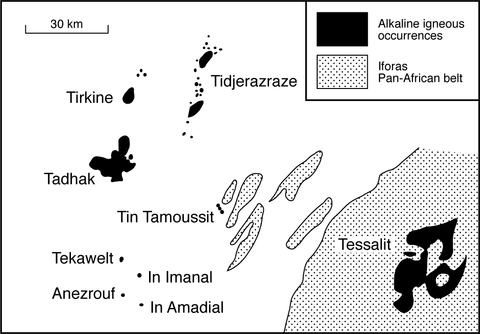stripes
An approximately circular complex 2 km in diameter, Anezrouf is composed dominantly of nepheline syenites with smaller intrusions of other igneous rocks scattered across and adjacent to it, including arcuate bodies of ijolite and pyroxenite close to the southern margin. Basement rocks are extensively fenitized to the north and west of the complex and areas mapped by Sauvage and Savard (1985) as fenites are also enveloped by the nepheline syenites. There are several small intrusions of carbonatite immediately east of the complex and there are many radiating carbonatite and phonolite dykes. The nepheline syenites comprise perthite, abundant nepheline, sodalite, cancrinite, which is possibly primary, aegirine-augite, sometimes with salite cores, and accessories including wollastonite, fluorite, calcite, zircon, pyrochlore and wohlerite. The ijolite to the south consists of nepheline and pyroxene which are enclosed poikilitically in large calcite crystals. The adjacent pyroxenite, which grades into melteigite, contains pyroxene, nepheline and biotite with a little apatite, calcite, sodalite, fluorite, titanite and pyrite. The area of fenitization within the complex, which has developed at the expense of alkaline rocks, is ascribed by Sauvage and Savard (1985) to rodbergite which forms a number of sinuous sheets throughout. Apatite and other phosphate minerals are associated with the rodbergite. The plugs and dykes of carbonatite include sovite, ferrocarbonatite and rauhaugite which contain pyrochlore.
SAUVAGE, J.-F. and SAVARD, R. 1985. Les complexes alcalins sous-saturés à carbonatites de la région d'In Imanal (Sahara malien): une presentation. Journal of African Earth Sciences, 3:143-9.


